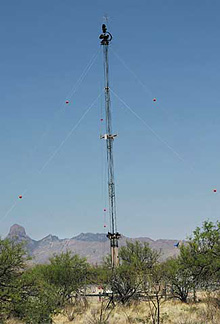
|  |  |  Technology News | May 2009 Technology News | May 2009  
Work to Start on US Virtual Fence
 Arthur H. Rotstein - Associated Press Arthur H. Rotstein - Associated Press
go to original


| | (AP/Arizona Daily Star/David Sanders) |  |
Tucson, Arizona - U.S. officials plan to start construction within weeks on a new "virtual fence" along the U.S.-Mexico border that they say could almost completely cover the nearly 2,000-mile frontier within five years.

The first permanent towers holding sensors, cameras and communications gear to detect drug smugglers and illegal immigrants will be built along 53 miles of Arizona's border with Mexico, said Mark Borkowski, a Customs and Border Protection official in charge of the program.

More towers, up to 120 feet tall and spaced miles apart, will follow on the remaining 320 miles of the state's southern border, under plans to be formally announced at a briefing Friday. Virtual fencing then will go up in New Mexico, followed by California and most of Texas, said Borkowski, executive director of the U.S. Homeland Security Department's Secure Border Initiative program.

"Construction should start imminently," Borkowski told The Associated Press in an interview late last week.

The plans follow a prototype virtual fence that federal officials and others found inadequate for the job, and Borkowski said improvement probably will be made to the final version after border agents begin using it.

Depending on funding, the whole southwestern border except for about 200 miles around Big Bend National Park in Texas would be covered by 2014, Borkowski said. That area would also eventually be outfitted with the system.

Plans for a virtual fence on the Canadian border aren't fully developed.

The electronic monitoring is meant to supplement pedestrian fencing and vehicle barriers that have been built along 624 miles of the southern border. About 46 more miles of fencing are planned.

Borkowski declined to estimate what the entire southwestern virtual fence project will cost, though Adam Comis, press secretary for the House Homeland Security Committee, said the cost is estimated to be about $6.7 billion by 2014.

The primary contractor, the Boeing Co., has received about $600 million so far for technology development on the initiative.

As of a year ago, Boeing also had received some $260 million for construction of physical border fences and vehicle barriers, primarily in Arizona and Texas.

The virtual fence is designed to use radar and cameras with about a six-mile range, including infrared devices and other technologies, to detect smuggling attempts. The sensors are designed to be able to distinguish people from animals and allow operators to direct Border Patrol agents to intruders.

A prototype virtual fence strung across 28 miles of the southern Arizona border has been in use since late 2007. |

 |
|  |



